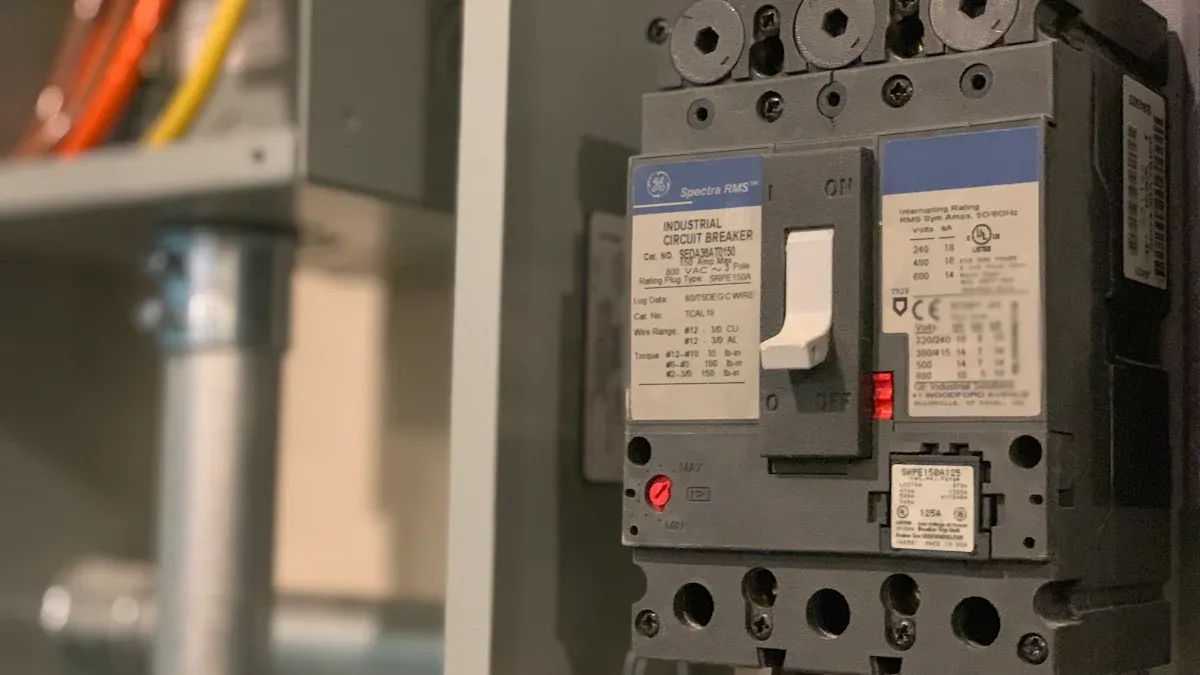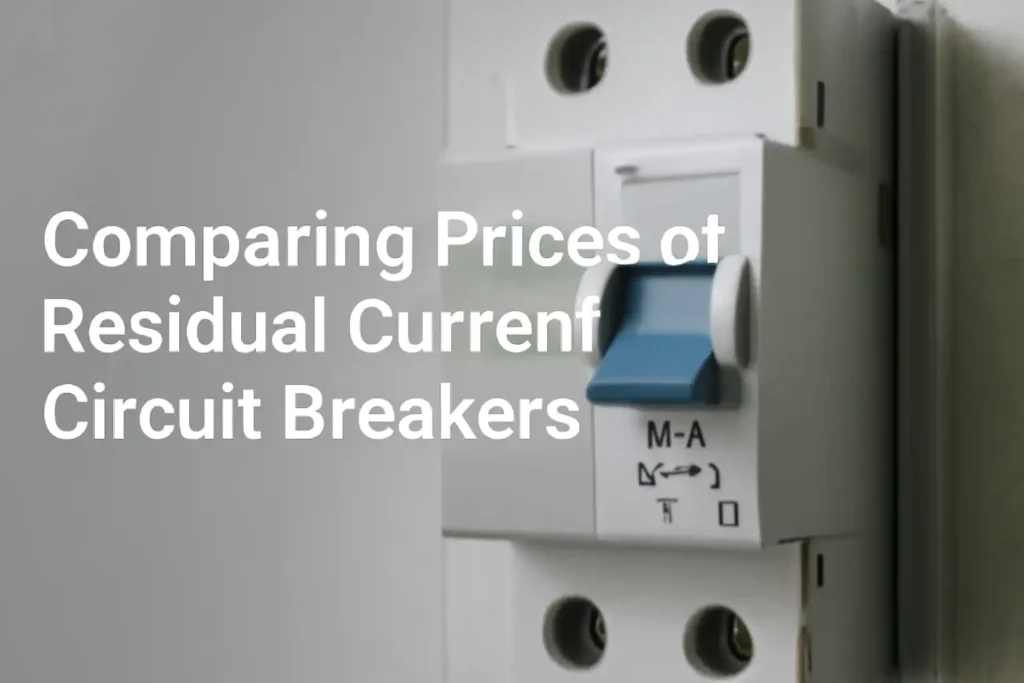Residual current circuit breakers have many prices, with the price of residual current circuit breaker starting at around $20 for basic models. Advanced models can cost over $200. Prices depend on the type and features, with single-phase models being cheaper than three-phase ones. Knowing the price of residual current circuit breaker options helps you pick the right model. Choose one that fits your budget and keeps you safe.
Key Takeaways
- Residual current circuit breakers cost between $20 and $300+. Pick one that fits your budget and keeps you safe.
- The brand name is very important. Renowned brands such as ONESTO Electric and Siemens may have higher costs, but they are more reliable.
- Know your electrical needs. Choose the right breaker for your system, like single-phase for homes or three-phase for businesses.
- Check for certifications like IEC, UL, and CE. Certified breakers are safer and meet important standards, making them worth it.
- Think about extra features. Options like smart monitoring and surge protection add safety but may raise the price.
Factors That Affect the Price of Residual Current Circuit Breakers
Knowing what affects the price of residual current circuit breakers helps you choose wisely. Prices depend on things like the brand, type, and technical details.
Brand and Manufacturer
Brand is an important factor in the cost of residual current circuit breakers. Famous brands charge higher fees because their quality is trustworthy. ONESTO Electric, Siemens, ABB and other companies produce reliable and durable products.
Smaller or newer brands may sell cheaper options. However, these might not have advanced features or important certifications. Compare the price with the brand’s reputation and reviews to find a dependable product.
Tip: Pick trusted brands if you want safety and durability.
Type of Circuit Breaker
The type of residual current circuit breaker also changes its price. Single-phase models are cheaper since they are simpler and made for homes. Three-phase models are pricier because they are used in factories and businesses.
Special types, like waterproof or heavy-duty models, cost even more. These are built for special uses, such as outdoor areas or tough industrial jobs.
- Main Types of RCCBs and Their Uses:
- Single-phase RCCBs: Best for houses and small offices.
- Three-phase RCCBs: Used in factories and big buildings.
- Specialized RCCBs: Made for wet or extreme environments.
Amperage and Voltage Ratings
The amperage and voltage ratings of a residual current circuit breaker affect its price. Higher ratings mean the breaker can handle more electricity, which is needed for bigger jobs. These models cost more because they are more advanced.
Here’s a simple comparison of ratings for different RCCBs:
| Type of RCCB | Current (A) | Voltage (kV) |
|---|---|---|
| RCCB | 1,250-4,000 | 4.16-40.5 |
| AC RCCB | 40-100 | 0.240-0.400 |
| RCCB | 25-80 | 0.230-0.440 |
| Differential RCCB | 16-80 | 0.100-0.195 |
| Thermal-Magnetic RCCB | 25-63 | 0.230-0.400 |
| RCCB with Overcurrent Protection | 6-40 | 0.240 |
| 4-pole RCCB | 25-100 | N/A |
Higher ratings are great for factories, but homes usually need lower ones. These are cheaper and work just fine.
Note: Pick an RCCB with the right ratings for your system. This saves money and avoids buying features you don’t need.
Certifications and Compliance Standards
Certifications are important for the safety of residual current circuit breakers. Always check if the breaker meets safety standards. These certifications show the product has been tested and is safe to use.
Here are some common certifications:
- IEC (International Electrotechnical Commission) Standards: These are known worldwide and ensure global safety rules are met.
- UL (Underwriters Laboratories) Certification: Popular in the U.S., it confirms the product is safe and reliable.
- CE Marking: Found in Europe, it shows the product follows European safety and health rules.
- RoHS Compliance: This means the breaker has no harmful materials and is eco-friendly.
Tip: Look for certifications on the label or box. Certified breakers are safer and worth the cost.
Using uncertified breakers can cause safety problems or electrical failures. Certified ones may cost more but are safer and last longer. This makes them a smart choice when comparing prices of residual current circuit breakers.
Additional Features and Smart Functionality
Modern residual current circuit breakers often have extra features for better use. These features make them safer and easier to manage but can raise the price.
Some advanced features include:
- Smart Monitoring: Lets you track electricity use and problems with an app.
- Self-Testing Mechanism: Automatically checks if the breaker is working properly.
- Surge Protection: Protects devices from sudden voltage increases.
- Waterproof and Dustproof Design: Good for outdoor or industrial areas, keeping water and dust out.
- Compact Size: Fits in small spaces where room is limited.
Note: Extra features add safety and ease but cost more. Decide if you need them before buying.
Smart features are great for modern homes and businesses. They help you manage electricity better. But if you only need basic functions, simpler models can save you money.
Price Comparison by Type of Residual Current Circuit Breaker

Single-Phase Models
Single-phase residual current circuit breakers work well for homes and offices. They are simple and cost less than other types. Basic models start at $20. Advanced ones with features like surge protection or smart monitoring can cost up to $100.
These breakers handle smaller electrical loads, making them great for houses. Their amperage ranges from 16A to 80A, and voltage is between 230V and 440V. If you want a budget-friendly option for home safety, single-phase models are ideal.
Tip: Pick single-phase models for systems with lower power needs. This saves money and keeps your home safe.
Three-Phase Models
Three-phase residual current circuit breakers are made for factories and businesses. They are more advanced and handle bigger electrical loads. Prices range from $50 to over $200, depending on features like waterproofing or self-testing.
These breakers are used in warehouses and large buildings. They usually have amperage ratings of 40A to 100A and voltage ratings of 400V or higher. Special features make them costlier but useful for tough jobs.
If your system needs high power, three-phase models are worth the cost.
Note: Three-phase models cost more but are needed for heavy-duty systems.
High-Amperage vs. Low-Amperage Models
The amperage rating affects the price of residual current circuit breakers. High-amperage models cost more because they handle larger loads. These start at $100 and can go over $300 for advanced versions.
Low-amperage models are cheaper and work for homes. Their prices range from $20 to $80. These are best for houses with lower power needs.
Here’s a simple comparison:
| Amperage Rating | Typical Use | Price Range |
|---|---|---|
| Low-Amperage (16A-40A) | Homes and small offices | $20-$80 |
| High-Amperage (100A+) | Factories and industries | $100-$300+ |
Choose the right amperage for your system. This keeps you safe and avoids spending too much.
Tip: Match the amperage to your system to save money and stay safe.
Specialized Breakers (e.g., Waterproof, Industrial-Grade)
Specialized residual current circuit breakers are made for tough places. These include waterproof and industrial-grade models, which are stronger and safer. They work well outdoors, in factories, or in areas with harsh conditions.
Features of Specialized Breakers
Specialized breakers have special features for specific needs. Waterproof ones block dust and water with a high protection level like IP20. Industrial-grade breakers handle more electricity, making them great for big machines and factories.
Here’s a simple list of features these breakers may have:
| Feature | Details |
|---|---|
| Product type | Residual current breakers with overcurrent protection (RCBO) |
| Rated current (In) | 6A to 63A |
| RCD Type | AC, A |
| Protection degree | IP20 |
| Rated residual operating current (IΔn) | 30mA to 300mA |
| Rated breaking capacity (Icn) | 6KA/10KA |
| Rated impulse withstand voltage (Uimp) | 4KV |
| Mechanical life | 10,000 cycles |
| Ambient temperature | -25°C to +40°C |
| Storage temperature | -25°C to +70°C |
These features help specialized breakers work well in extreme conditions.
Price Range and Applications
The price of these residual current circuit breakers depends on their features. Waterproof models start at $50 and can go over $200 for advanced ones. Industrial-grade breakers cost between $100 and $300 because they are built for heavy-duty use.
Use specialized breakers in places with moisture, dust, or extreme heat. Waterproof ones are great for outdoor lights. Industrial-grade breakers are best for factories and warehouses.
Tip: Pick a breaker that fits your environment. This keeps your system safe and reliable.
Why Choose Specialized Breakers?
Specialized breakers are safer in places where regular ones might fail. They cost more but last longer and protect better. Choosing the right breaker saves money on repairs and keeps your system safe.
Where to Buy Residual Current Circuit Breakers
Online Retailers
Online stores make buying residual current circuit breakers easy. You can check many products, compare prices, and read reviews from home. Websites like TradeSparky sell trusted brands that focus on safety and quality.
Some online shops offer advanced models like Din Rail RCBOs. These combine RCD and MCB functions for better protection. If you want modern options, online stores often have the newest designs. Many sites also adjust prices to give you good deals.
Tip: Choose online stores with good reviews and helpful service. This makes shopping simple and stress-free.
Local Hardware Stores
Local stores are great if you want to see the product first. They usually sell basic residual current circuit breakers for homes and offices. Store staff can help you pick the right breaker for your needs.
Buying locally supports nearby businesses. While choices may be fewer than online, you can still find trusted brands at fair prices. Some stores also offer sales or special deals on electrical items.
Note: Visit a local store for quick replacements or expert advice.
Wholesale Suppliers
Wholesale suppliers are best for buying many residual current circuit breakers. If you need breakers for a big project, wholesalers offer discounts for bulk orders. This saves money for contractors and businesses.
ONESTO wholesalers have years of experience in selling reliable products. There are various models available, including industrial grade and waterproof circuit breakers. This can ensure that you find the right circuit breaker for any job.
Tip: Reach out to wholesalers for large orders at lower prices.
Pricing Trends Across Different Sources
Knowing how prices differ by source helps you shop smarter. Each option has its own benefits and price ranges based on your needs.
1. Online Retailers
Online stores often have lower prices because they save on costs. Basic residual current circuit breakers start at $20. Advanced ones with smart features can cost up to $200. Sales and discounts can make them even cheaper. Websites like Amazon or electrical shops sometimes offer bundles, which are great for buying multiple units.
Tip: Use tools or apps to compare prices and find the best deal online.
2. Local Hardware Stores
Local stores usually charge more than online shops. Basic models start at $25, and advanced ones can go over $220. But they offer quick access and helpful advice. If you need a replacement fast or want to see the product first, local stores are a good choice.
Note: Some stores give discounts or rewards for loyal customers.
3. Wholesale Suppliers
Wholesale suppliers are great for buying in bulk. They give big discounts for large orders. For example, one unit might cost $18 in bulk, compared to $25 at a store. Wholesalers also sell industrial-grade and special breakers that are hard to find elsewhere.
| Source | Price Range (Basic Models) | Price Range (Advanced Models) | Best For |
|---|---|---|---|
| Online Retailers | $20-$200 | $50-$300 | Individual buyers, modern features |
| Local Hardware Stores | $25-$220 | $60-$320 | Immediate needs, expert advice |
| Wholesale Suppliers | $18-$180 (bulk pricing) | $40-$250 | Bulk orders, industrial use |
Final Thoughts
Prices change depending on where you shop. Online stores are convenient and offer deals. Local shops give advice and quick access. Wholesalers are best for bulk buying. Pick the source that fits your budget and needs.
Reminder: Always check certifications and warranties before buying. This keeps you safe and ensures the product lasts.
Tips for Choosing the Right Residual Current Circuit Breaker
Balancing Cost and Quality
Picking a residual current circuit breaker means balancing price and quality. Don’t buy the cheapest one without checking its safety. Cheap breakers might not last or protect well. Expensive ones may have features you don’t need.
To find the right balance:
- Set a budget: Decide how much you can spend before shopping.
- Compare features: Pick models with key safety features in your budget.
- Read reviews: See what other buyers say about the product’s performance.
Tip: Spending more on a trusted brand gives better safety and durability.
Understanding Your Electrical Needs
Knowing your system’s needs helps you pick the right breaker. Match the breaker type to your setup. Single-phase models are good for homes. Three-phase models work for factories or businesses.
Steps to figure out your needs:
- Check voltage and amperage: Match the breaker’s ratings to your system.
- Think about the environment: Outdoor setups need waterproof breakers.
- Plan for upgrades: Choose a breaker that supports future system growth.
Reminder: Using the wrong breaker can cause safety problems or damage.
Checking Certifications and Safety Standards
Certifications show the breaker meets safety rules. Always look for labels like IEC, UL, or CE. These prove the breaker is tested and safe to use.
Here’s a simple guide to certifications:
| Certification | Region | Purpose |
|---|---|---|
| IEC | Worldwide | Meets global safety standards |
| UL | United States | Confirms product reliability |
| CE | Europe | Follows EU safety rules |
Note: Certified breakers cost more but are safer and more reliable.
Skipping certifications can lead to unsafe systems. Always choose safety over saving money when buying a residual current circuit breaker.
Comparing Warranties and Customer Reviews
Warranties and customer reviews are important when picking a residual current circuit breaker. They show how reliable the product is and if the maker trusts its quality.
Why Warranties Matter
A warranty keeps your money safe. It promises the maker will fix or replace the breaker if it breaks within a set time. Big brands like Schneider Electric and Siemens give warranties from one to five years. Longer warranties often mean better quality. Always check the warranty details. Some only cover factory problems, while others include regular wear.
Tip: Pick a breaker with a warranty that fits how you’ll use it. This gives you peace of mind and good value.
What Customer Reviews Tell You
Customer reviews share real-life experiences with the breaker. They show what’s good and bad about it. For example:
- Many people like Hager and Eaton breakers because they’re easy to find and use.
- One buyer said Noark RCDs worked perfectly for four years without issues.
Reviews help you see how the breaker works in different places. Look for repeated comments. If many say it’s durable and safe, that’s a good sign. But if lots of people mention problems, be careful.
Note: Read reviews from people with needs like yours. This makes the advice more useful for your situation.
By checking warranties and reviews, you can choose wisely. A breaker with good reviews and a strong warranty gives the best value for your money.
Residual current circuit breakers have prices ranging from $20 to over $300. The cost depends on factors like brand, type, amperage, and certifications. In 2023, the global market for these breakers was worth $4.12 billion. It is expected to grow by 6.50% yearly due to more construction and smart home use. But, high upfront costs and tricky installations are still issues.
To pick the right breaker, match it to your budget and needs. Focus on safety and quality instead of just price. Certified breakers are safer and last longer, making them a smart buy.
Tip: Pick a breaker that fits your system and meets safety rules.
FAQ
What is a residual current circuit breaker (RCCB)?
An RCCB is a device that keeps you safe from electric shocks. It notices when electricity leaks and quickly turns off the power. This stops accidents and helps avoid electrical fires.
Tip: Use RCCBs in wet areas or places needing extra safety.
How do I choose the right RCCB for my home?
Check your system’s voltage and amperage needs first. For most homes, single-phase RCCBs with 16A to 80A ratings work well. Pick certified models for better safety.
Note: Ask an electrician if you’re unsure about your system.
Are expensive RCCBs always better?
Not necessarily. Costlier RCCBs may have extra features like waterproofing or smart monitoring. But basic models are often enough for home use. Choose an RCCB based on your needs, not just the price.
Can I install an RCCB myself?
No, you shouldn’t install an RCCB unless you’re a licensed electrician. Doing it wrong can cause safety risks or damage your system. Always hire a professional to set it up correctly.
How often should I test my RCCB?
Test your RCCB every three months. Most have a “test” button. Press it to check if it shuts off properly. Regular testing keeps your RCCB working well.
Reminder: Replace your RCCB right away if it doesn’t pass the test.
The following information may be of interest to you
RCBO and RCCB explain for beginners
How to gradually and correctly install B-class residual current devices
How to solve RCCB tripping problem at home
Top 8 Residual Current Circuit Breaker Brands for Home Safety





